
Acropora is a genus of small polyp stony coral in the phylum Cnidaria. Some of its species are known as table coral, elkhorn coral, and staghorn coral. Over 149 species are described. Acropora species are some of the major reef corals responsible for building the immense calcium carbonate substructure that supports the thin living skin of a reef.

Montipora is a genus of Scleractinian corals in the phylum Cnidaria. Members of the genus Montipora may exhibit many different growth morphologies. With eighty five known species, Montipora is the second most species rich coral genus after Acropora.

Goniopora, often called flowerpot coral, is a genus of colonial stony coral found in lagoons and turbid water conditions. Goniopora have numerous daisy-like polyps that extend outward from the base, each tipped with 24 stinging tentacles which surrounds a mouth.

Pocillopora is a genus of stony corals in the family Pocilloporidae occurring in the Pacific and Indian Oceans. They are commonly called cauliflower corals and brush corals.
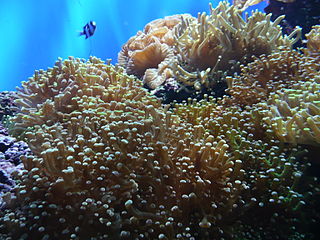
Euphyllia is a genus of large-polyped stony coral. Several species are commonly found in marine aquariums. The genus includes the following species:

Galaxea is a genus of colonial stony corals in the family Euphylliidae. Common names include crystal, galaxy, starburst and tooth coral. They are abundant on reefs in the Indo-Pacific region and the Red Sea. They are found in water less than 20 metres (66 ft) deep and favour turbid sites. They are sometimes kept in reef aquaria.

Pavona is a genus of colonial stony corals in the family Agariciidae. These corals are found in shallow waters in the Indo-Pacific region.

Alveopora is a genus of colonial stony corals in the family Acroporidae. Members of this genus are native to the Indo-Pacific region and are often found on reef slopes in turbid water. They are generally uncommon.

Echinopora is a genus of stony corals in the family Merulinidae.
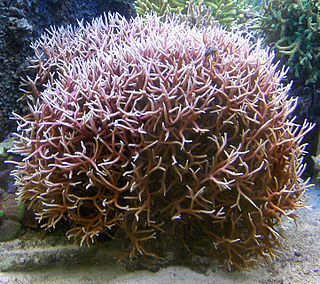
Seriatopora is a genus of colonial stony corals in the family Pocilloporidae. They are commonly known as needle corals, birdsnest corals or finger corals. They are native to the Red Sea, the Indo-Pacific region and some parts of the Central Pacific Ocean.
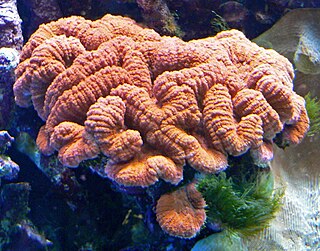
Lobophylliidae is a family of large polyp stony corals. The family was created in 2009 after a revision of the "robust" families of Faviidae, Merulinidae, Mussidae and Pectiniidae, which had been shown to be polyphyletic. The family Lobophylliidae was formed out of the Indo-Pacific species that had traditionally been included in Mussidae, and some of the species which had previously formed Pectiniidae, the remaining species from Pectiniidae having been merged into Merulinidae. The type genus is Lobophyllia.

Turbinaria is a genus of colonial stony corals in the family Dendrophylliidae. Common names for this genus include disc coral, scroll coral, cup coral, vase coral, pagoda coral and ruffled ridge coral. These corals are native to the Red Sea, Indian Ocean, Japan and the south Central Pacific Ocean.

Dendrophyllia is a genus of stony cup corals in the family Dendrophylliidae. Members of this genus are found at depths down to about 900 metres (3,000 ft). They are azooxanthellate corals, meaning that they do not contain symbiotic photosynthetic dinoflagellates as do many species of coral.

Favites is a genus of stony corals in the family Merulinidae. Members of this genus are native to the Indo-Pacific region and their ranges extend from the Red Sea through the Indian Ocean and Western Pacific Ocean as far as Japan, the Line Islands and the Tuamotu Islands.
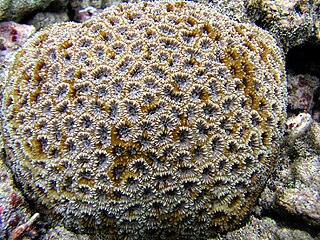
Dipsastraea is a genus of stony corals in the family Merulinidae. Members of this genus are native to the Indo-Pacific region. They are zooxanthellate corals.

Merulina is a genus of stony corals in the family Merulinidae. Members of this genus are native to the Indo-Pacific region and their ranges extend from the Red Sea through the Indian Ocean as far as Japan and the southern central Pacific Ocean. Merulina ampliata is the type species.

Oulophyllia is a genus of stony corals in the family Merulinidae. Members of this genus are native to the tropical western and central Indo-Pacific region.

Oxypora glabra is a species of large polyp stony coral in the family Lobophylliidae. It is a colonial coral with thin encrusting laminae. It is native to the central Indo-Pacific.
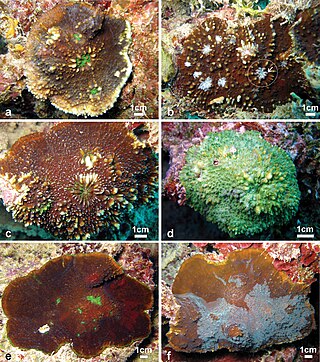
Echinophyllia is a genus of large polyp stony corals. Members of this genus are colonial corals and are generally foliaceous, usually with very thin leaves. They are native to the Indo-Pacific and are sometimes found in reef aquariums.

Pectinia is a genus of corals belonging to the family Merulinidae.





















